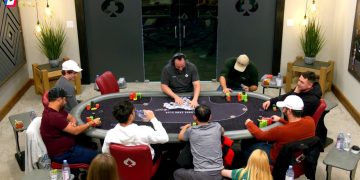What Is a Value Bet In Poker?
A “Value Bet” is a wager that occurs when you put your opponent on a hand, and suspect your hand is better and expect to have more equity than your opponent. This is a poker strategy professional poker players use to maximize their winnings and wager up the amount in the pot. An effective “Value Bet” gets an opponent to call, typically because your opponent believes their poker hand is stronger. Make the “Value Bet” an essential part of your Texas Hold’em strategy.
Let’s spend a minute talking about how you’re going to make money at the table. When you’re playing a poker game, the rule for making money is pretty simple – you’re looking to place a bet that’s going to cause the other players to give you as much money as possible. The concept you’re looking at is called a value bet, and it’s a bet that’s perfectly tailored to put more money in your pocket when the other guy’s hand is worse than yours.
Betting for value is the opposite of what new players do these days, which is betting conservatively on the river just in case the other players have something that might end up beating them. This isn’t how you win poker tournaments, and it’s a fairly well-known truth in Texas Hold’em poker that being conservative isn’t always going to pay off.
What’s your goal, then? It’s to get ahead, and then to stay that way. You’re going to have to learn how to read your opponent’s hand, establish a range, and learn what it means to maximize your gains whenever doing so is a smart move. Once you’re there, then you can start worrying about what you’re going to do in case somebody has a good hand or what happens when you get beaten.
What you’re really looking for, in short, is value. Value betting is one part of your poker strategy that’s got to be perfect if you want to take your game to the next level.
Value Bet and Expected Value

This is a little easier to talk about when you’re looking at money, so let’s pretend that you’re in a real game. You’ve got a stack on the table, and what’s in the pot is more than ten times what you’ve already got out. What’s your opponent going to do? In truth, you can’t know. What you can, however, start to put together is the odds on how confident you are – now confident that your opponent’s got a worse hand with you and is going to call anyway.
How confident are you? You can put a number on it, if you want. You might say that you’re around seventy-five percent confident that not only do you have the best hand, but that your opponent’s not going to hold a better hand than what’s out right now. Furthermore, let’s say that you’re a solid twenty percent sure that your opponent’s going to hold on something even worse – that happens, after all, and you have to account for it.
So, what does that leave you? Your expected value is about a fifty percent chance that you’re going to get called and you’re going to win. That might be an even split, but those odds aren’t actually all that bad in a game of poker. It also means that if you had chosen to bet this time instead of checking, you’d take home a little bit more money. Maybe not all of it, but enough to justify taking the risk.
Value Bet: The Size of Your Bet

There’s an awful lot of thought that goes into how you size up your bet. If you’re looking at a value bet, what you’re really doing is spending some time looking at an individual board and the players before you make your move. You’re looking at the board texture, sure, but also the specific situation you’re in. What you want to do is to figure out how to maximize the tendency of your opponents to call your hand when you’ve got something that’s going to win.
A good way to think about this is by looking at a value bet as a lure. What kind of lure are you going to use to catch the biggest fish possible most of the time? That’s a question that’s also going to require a little more thought.
The common wisdom – which isn’t always all that great – is that small bets are going to get called. Small bets represent weak hands to some players, after all, and more players call when they think they are going to win. Fairly easily train of thought to follow, right?
The problem with this is that you’re going to fall prey to the law of diminishing returns. You’re not going to be winning much, but you are going to get called quite a bit. At some point, the odds are going to go against you and you’re going to get your stack chipped away.
To go totally against those basic poker rules you may have been taught, big best can actually bring in a significant number of calls on their own. These bets are often read as bluffs, after all, and aggressive players will come after you like you’re wounded prey. Instead of thinking big or small, what you really need to think is “how can I make the most money?”
It’s always worth remembering that bigger bets don’t always mean that you’re going to get called more often, but they do mean that you’re going to end up winning more money when you are successful. Figuring out that perfect balance between risk and reward is how good poker players determine what’s a real value bet and what’s going to put them out of a poker tournament.
Talking About Value

If you want to get into the world of the value bet, you’ve got to understand the concept of this value. Thin value is a bet that relies on the opponent having a relatively small range that’s going to allow him or her to call you when he or she has a worse hand than you. Yes, this all comes back to reading your opponent – that big skill you’re going to need to start winning poker games.
This is the spot where you’re going to be betting just a little bit of money, because the odds are not necessarily flowing the way you want. You’re going to be pushing into new territory here, learning the trick that the pros use to slowly but surely increase their winnings.
As always, a hypothetical makes things a little easier.
We’ll pretend like you’re in a fairly small cash game here, with a two dollar big blind. You go ahead raise up to six, because you are feeling good and think that you’ve got something worthwhile. The small blind meets you, but the big blind folds. There are now fourteen dollars in the pot (your six, the small blind’s six, and the big blind’s two).
When the flop comes out, you’re in the aggressive position again. You bet another eight after the small blind checks to you, which is (fairly obviously) going to lead to call. Again, nothing out of the ordinary. So what happens when the small blind checks again after the turn?
Well, let’s say that you check. Given the small blind’s play pattern, he’s probably going to check again unless something amazing happens. Most people are going to tell you to play conservatively here and check behind. After all, you’ve raised a good bit and you don’t want to lose.
Most people, of course, are wrong.
In our hypothetical, the small blind is a decent player. That means that if he matched our raise before the flop, he’s probably got a preferred hand. He’s probably got either a high face pair or a fairly strong ace, so there’s a rather limited range of things with which he could be playing and still just checking around. Given that he’s been checking and not check-raising, the odds of him having something better than you are fairly slim.
Once the river comes out, you can narrow down what’s in his hand. He probably doesn’t have that pair of Aces and he’s definitely not working on a straight, or he would have bet more strongly. Statistically speaking, your opponent has something that could beat an average player, but the odds are strongly in favor of you taking home the pot.
Let’s go with the strongest odds here and guess that the opponent is coming at us with a pocket pair that’s not as good as what we have in our hand. You can’t bet too much here, because that’s got better odds of pushing him out with a lower payout than making him think you’re bluffing. We’re going for the titular thin value here, so we’re going to bet small enough that he’s going to feel comfortable, but big enough that it’s worth our time.
There are, as ever, things to worry about here. When you’re in this kind of position, you really are dancing on the edge of a razor. You’ll end up folding to a raise sometimes, and you’re going to have to write off that money. You’ll get beaten from time to time, and that’s fine. What you’re looking at is the big picture, the way you’re going to win more poker games instead of the way you’re just going to win this hand.
Dealing with River Bets

Another big part of dealing with a value bet is learning how to deal with river bets. Yes, you’re going to pay a lot of attention to what you had starting off and what came in the flop, but you’re going to push for value when you get to the river. It’s in the river that things get interesting and ultimately where you can make your money.
It’s important to remember that there’s a big difference between this and slow-playing. Poker pros know slow-plays and those players who don’t will read the kind of weakness in your hand that doesn’t work for this kind of strategy. You’re looking to walk the very thin line between over-committing and being too harmless, and that’s something that takes time to accomplish.
The benefit of walking this line, though, cannot be overstated. You’re going to bring in much more money and win more games, taking risks that are worthwhile so that you win more often than not. Value betting is all about knowing how to bring in more in those situations that are more likely to go in your favor.
Final Thoughts
When you get to the river, your goal as a poker player is to figure out how to make the most money possible. This means learning how to read specifically, determining if you can maneuver the other player into a position that’s going to maximize your value. It can seem risky from the outside, but what you’re really playing is the numbers.
value bet – river
In the end, a value bet is how you figure out how much money you can make on any given hand. It gives you the best odds of winning more over time, not just in one hand but in every game you play. If you want to get serious about making money while playing poker, you’ve got to start learning how to make every bet a value bet. See you at the WSOP!
♠ pokerjournal.org
Value Bet – FAQ
What is a value bet in poker?
A value bet is when you don't want to bet too much because you have the winning hand and you want your opponent to call. You can also overbet sometimes because it looks weak.
What is a thin value bet?
A thin value bet is when you only have a marginal hand but still think it's the best hand. You need good reading ability to pull this off.
How do I know I have the best poker hand?
Unless you have the nuts, you don't know. However, if you trust your reads based on betting patterns, you might know. If your opponent keeps checking, you probably have the best hand.
What is a 4-bet?
A 4-bet is when a player makes the forth bet/raise/on any street. A pre-flop 4-bet usually indicates AA or KK, but not always.



















Discussion about this post